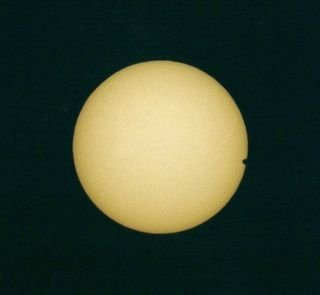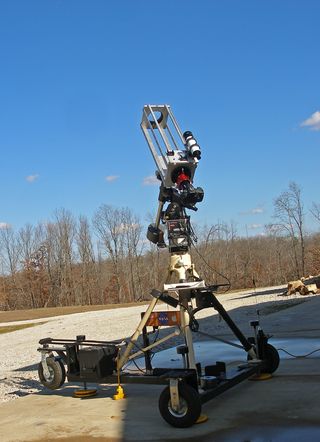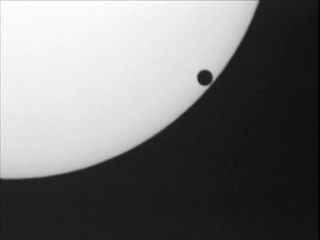
Celestial Showstopper: The Only Venus Transits I'll Ever See (Op-Ed)
Victor Rogus is an amateur astronomer, and this is the seventh in his series of exclusive Space.com posts about amateur astronomy. He contributed this article to Space.com's Expert Voices: Op-Ed & Insights.
Solar transits are exciting opportunities to capture images of historic celestial events. Many things, natural and manmade, can cross the face of the sun: Airplanes, the International Space Station, sun spots and the two inner planets — Venus and Mercury — can at times be seen crossing the solar disk from our Earthly vantage point.
Two times during my life, I witnessed and photographed Venus as it crossed the face of the sun. For me, the event impressed me in ways I did not expect — it put the planets into perspective with their star.
First encounter
My first chance to capture Venus transiting the sun was on June 8, 2004. I used a 5-inch apochromatic telescope at f9 in conjunction with an over-the-aperture solar filter. Any time one views or photographs the sun, great care must be exercised to avoid the risk of going permanently blind. Similar to viewing a solar eclipse, transits require proper filtering. An over-the-aperture solar filter is made of an aluminized Mylar film that presents a safe, white-light image of the sun. Such filters are inexpensive, much more durable than they look and work well — and while they come with various attachment options, I always use electrical tape to secure them to the telescope. Without tape securing the filter, an ill-timed gust of wind could blow a poorly attached solar filter off of the telescope as you or guests are at the eyepiece, directly viewing the sun.
In 2004, I was still using film cameras, so I planned to use Kodak Ektachrome slide film to capture the event. Back in the day, this film was one of the best for planetary imaging and capturing fine detail. And I also planned to make the image right from my home in Prospect Heights, Illinois. Daytime astronomy from my own suburban backyard — wonderful!
That event further impressed on me the importance of being in the right place at the right time, because in my amazement, there it would be, right on schedule, the planet Venus transiting the sun — never had I seen such a sight! In later years, the idea of precise timing would become my keenest interest in photographing the amazing clockwork of the universe — I would build my astronomy photography portfolio on this concept. On that June 8th day, the sky was clear and the sun shone bright, my telescope mount aligned to the celestial pole from the night before. I found privacy behind the huge bushes that surrounded our suburban acre and waited for the transit to begin. [With Simple, Homemade Telescopes, You Can Explore the Stars (Op-Ed )]
Get the Space.com Newsletter
Breaking space news, the latest updates on rocket launches, skywatching events and more!
Back in the days of film photography, it was critical to make good notes of exposure data of various celestial objects, like the sun and the various phases of the moon, information that gave a great starting point for one to begin bracketing exposure times for a good image. The results would then not be known until the film was developed and the event long over. I remember the thrill of seeing Venus as it made its trek across the sun — how small it was, I thought, but how clearly it was revealed through my camera's viewfinder. After reviewing my images I found this one to be the best as here we see Venus exiting the solar disk:

Second encounter
My second and last chance to capture Venus transiting the sun would happen several years later, on June 5, 2012, when I was again blessed with strikingly clear skies. Once again, I would use the same 5-inch apochromatic refractor at f9, but this time I planned to make a black-and-white video of the event with a digital camera from my home in Jadwin, Missouri. This time I would use a Baader Herschel solar prism safety wedge in place of the over-the-aperture solar filter, because in my opinion it rendered better detail and created a sharper image. I also selected a solar continuum and a ND 1.8 filter for this image. The camera was a Sony device originally designed for home-security use. Amateur astronomers had discovered that the low-light sensitivity of the camera made for nice planetary, lunar and solar imaging by way of video — for not a lot of cash. In my case, I had the camera tied directly to a DVD burner that sat on a custom shelf mounted to one of my tripod's legs. Here in Jadwin, I had built a custom three-wheeled cart with leveling jacks that could move an equatorial mount, counterweight, power source and a weather radio around the yard to take advantage of various vantage points for celestial events. A home-built cart can carry various optical tube assemblies. Set up on the far eastern side of our land, leveled and polar aligned from the night before, my astronomy cart, my wife and I, and two curious neighbors waited for the sun to cross the sky. With exacting preparation came exciting anticipation.

Then, it came. Huddled under a yard of black velvet I used to shield my vision from the glare of daylight, I spied the first tiny defect in the perfect circle of the solar disk. Venus had once again begun to pass in front of the sun. This was the critical time — checking the focus one last time, I burned my digital-video image. It looked beautiful to me in high contrast black and white. This camera naturally enlarged the image because of the image sensor format, specifically its shape and size, so I was able to gain magnification without the use of an eyepiece.
Only when the transit was fully under way, did I share the LCD screen and the image on it with my guests. They were truly amazed, and that what they were seeing was actually several minutes in the past, looking back in time, as the sun lies some 8 light-minutes away. Somehow this idea of "light-minutes" seems to impress some people more than the concept of millions of light-years, which arises when viewing stars.
We made an hour-long video of the awe-inspiring spectacle, but what was most impressive to me was that the planet Venus, similar in size to the Earth, appeared so small and insignificant when compared to the sun. If we traded places in our orbits and I could see the Earth in place of Venus as it slowly crossed the solar disk, I would see everything I knew — all the animals, the billions of human inhabitants of the Earth, their problems, their joys, their hopes, their dreams, the great cities, the forests, the deserts, the oceans — all on this tiny dot passing across the face of the star we call Sol.

This idea gives me chills. It also gives me hope that we humans, as a species, can understand how sacred our planet is and how blessed we are to have a chance to live, expand and survive on this tiny island home we call Earth.
I hope these images serve as a reminder of how fragile, and inconsequential, the Earth is when compared to the rest of the universe. Through understanding and international cooperation, we have a chance to save this world from the many dangers we face both on and off our planet.
The next time a Venus transit of the sun will be visible from anywhere on the Earth will be December 2117, and after that, in December 2125. Perhaps none of us alive today will live to see the event again.

Space.com is hosting a slideshow of Rogus' images.
Rogus' most recent Op-Ed was "My Time with Comet Lovejoy." The views expressed are those of the author and do not necessarily reflect the views of the publisher. This version of the article was originally published on Space.com.
Join our Space Forums to keep talking space on the latest missions, night sky and more! And if you have a news tip, correction or comment, let us know at: community@space.com.
